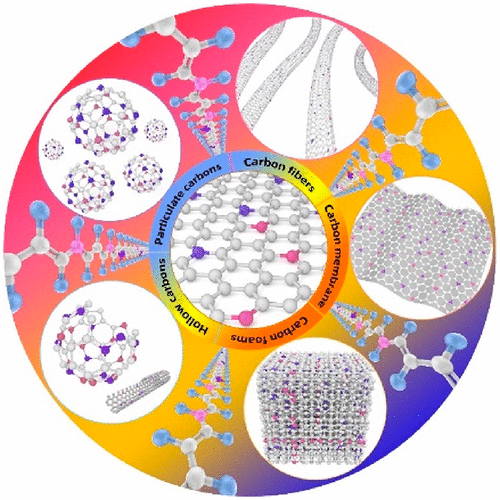当前位置:
X-MOL 学术
›
Chem. Rev.
›
论文详情
Our official English website, www.x-mol.net, welcomes your feedback! (Note: you will need to create a separate account there.)
Polymer-Derived Heteroatom-Doped Porous Carbon Materials.
Chemical Reviews ( IF 62.1 ) Pub Date : 2020-08-06 , DOI: 10.1021/acs.chemrev.0c00080 Hong Wang 1 , Yue Shao 1 , Shilin Mei 2 , Yan Lu 2, 3 , Miao Zhang 4 , Jian-Ke Sun 4, 5 , Krzysztof Matyjaszewski 6 , Markus Antonietti 7 , Jiayin Yuan 4
Chemical Reviews ( IF 62.1 ) Pub Date : 2020-08-06 , DOI: 10.1021/acs.chemrev.0c00080 Hong Wang 1 , Yue Shao 1 , Shilin Mei 2 , Yan Lu 2, 3 , Miao Zhang 4 , Jian-Ke Sun 4, 5 , Krzysztof Matyjaszewski 6 , Markus Antonietti 7 , Jiayin Yuan 4
Affiliation

|
Heteroatom-doped porous carbon materials (HPCMs) have found extensive applications in adsorption/separation, organic catalysis, sensing, and energy conversion/storage. The judicious choice of carbon precursors is crucial for the manufacture of HPCMs with specific usages and maximization of their functions. In this regard, polymers as precursors have demonstrated great promise because of their versatile molecular and nanoscale structures, modulatable chemical composition, and rich processing techniques to generate textures that, in combination with proper solid-state chemistry, can be maintained throughout carbonization. This Review comprehensively surveys the progress in polymer-derived functional HPCMs in terms of how to produce and control their porosities, heteroatom doping effects, and morphologies and their related use. First, we summarize and discuss synthetic approaches, including hard and soft templating methods as well as direct synthesis strategies employing polymers to control the pores and/or heteroatoms in HPCMs. Second, we summarize the heteroatom doping effects on the thermal stability, electronic and optical properties, and surface chemistry of HPCMs. Specifically, the heteroatom doping effect, which involves both single-type heteroatom doping and codoping of two or more types of heteroatoms into the carbon network, is discussed. Considering the significance of the morphologies of HPCMs in their application spectrum, potential choices of suitable polymeric precursors and strategies to precisely regulate the morphologies of HPCMs are presented. Finally, we provide our perspective on how to predefine the structures of HPCMs by using polymers to realize their potential applications in the current fields of energy generation/conversion and environmental remediation. We believe that these analyses and deductions are valuable for a systematic understanding of polymer-derived carbon materials and will serve as a source of inspiration for the design of future HPCMs.
中文翻译:

聚合物衍生的杂原子掺杂多孔碳材料。
已发现杂原子掺杂的多孔碳材料(HPCM)在吸附/分离,有机催化,传感和能量转换/存储中得到了广泛的应用。明智地选择碳前驱物对于制造具有特定用途和最大化其功能的HPCM至关重要。在这方面,作为前体的聚合物由于其通用的分子和纳米级结构,可调节的化学组成以及丰富的加工技术(结合适当的固态化学可在整个碳化过程中得以保持)而产生的质地得到了广泛的应用。本综述从如何产生和控制其孔隙率,杂原子掺杂效应,形貌及其相关用途等方面全面综述了聚合物衍生的功能性HPCM的进展。第一,我们总结并讨论了合成方法,包括硬和软模板方法以及采用聚合物控制HPCM中孔和/或杂原子的直接合成策略。其次,我们总结了杂原子掺杂对HPCM的热稳定性,电子和光学性质以及表面化学的影响。具体地,讨论了杂原子掺杂效应,其涉及单类型杂原子掺杂和两种或更多种类型的杂原子共掺杂到碳网络中。考虑到HPCM的形态在其应用范围内的重要性,提出了合适的聚合物前体的潜在选择以及精确调节HPCM的形态的策略。最后,我们提供了有关如何通过使用聚合物来预定义HPCM的结构的观点,以实现其在当前能量产生/转化和环境修复领域中的潜在应用。我们相信,这些分析和推论对于系统地了解聚合物衍生的碳材料是有价值的,并且将为未来HPCM的设计提供灵感。
更新日期:2020-09-10
中文翻译:

聚合物衍生的杂原子掺杂多孔碳材料。
已发现杂原子掺杂的多孔碳材料(HPCM)在吸附/分离,有机催化,传感和能量转换/存储中得到了广泛的应用。明智地选择碳前驱物对于制造具有特定用途和最大化其功能的HPCM至关重要。在这方面,作为前体的聚合物由于其通用的分子和纳米级结构,可调节的化学组成以及丰富的加工技术(结合适当的固态化学可在整个碳化过程中得以保持)而产生的质地得到了广泛的应用。本综述从如何产生和控制其孔隙率,杂原子掺杂效应,形貌及其相关用途等方面全面综述了聚合物衍生的功能性HPCM的进展。第一,我们总结并讨论了合成方法,包括硬和软模板方法以及采用聚合物控制HPCM中孔和/或杂原子的直接合成策略。其次,我们总结了杂原子掺杂对HPCM的热稳定性,电子和光学性质以及表面化学的影响。具体地,讨论了杂原子掺杂效应,其涉及单类型杂原子掺杂和两种或更多种类型的杂原子共掺杂到碳网络中。考虑到HPCM的形态在其应用范围内的重要性,提出了合适的聚合物前体的潜在选择以及精确调节HPCM的形态的策略。最后,我们提供了有关如何通过使用聚合物来预定义HPCM的结构的观点,以实现其在当前能量产生/转化和环境修复领域中的潜在应用。我们相信,这些分析和推论对于系统地了解聚合物衍生的碳材料是有价值的,并且将为未来HPCM的设计提供灵感。


























 京公网安备 11010802027423号
京公网安备 11010802027423号